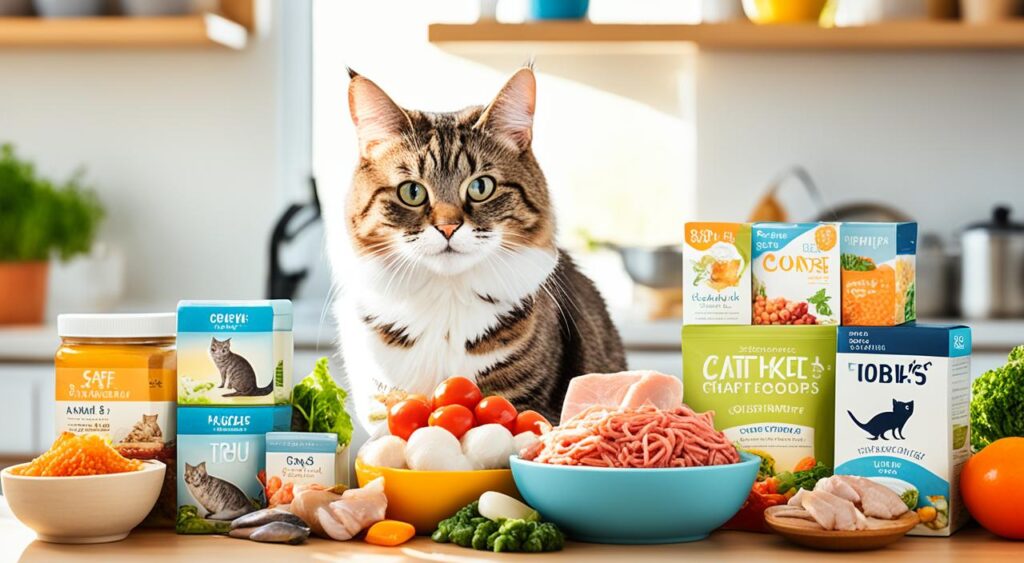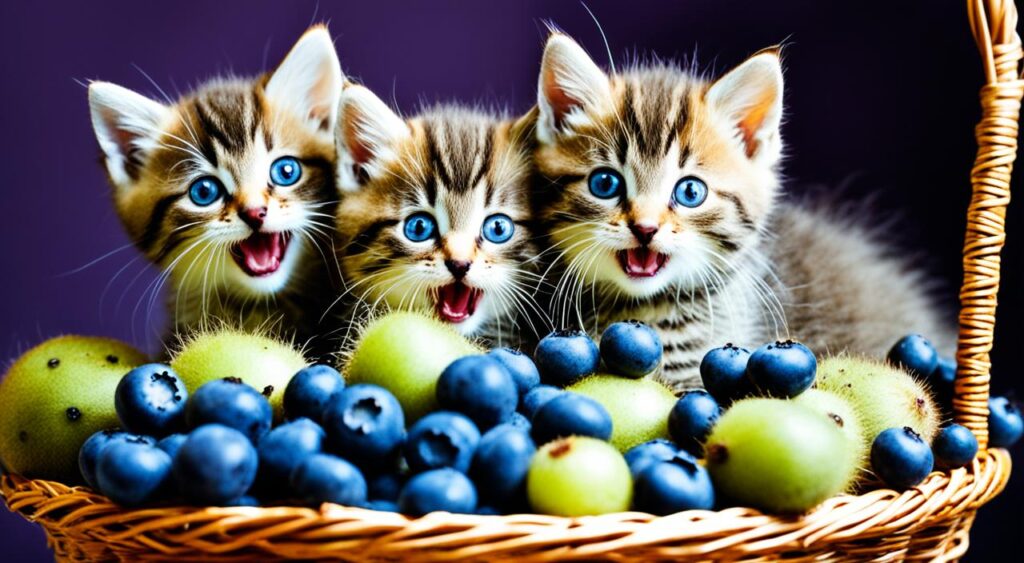
As a caring cat owner, you might often ask, what can my cat eat? It’s crucial to know what your cat needs to stay healthy and happy. Cats are obligate carnivores, which means they mainly eat animal proteins. While they mostly get their nutrients from meat, some human foods can be good for them in small amounts. This guide will show you safe foods for cats that can make their diet better without harming their health.
Key Takeaways
- Cats primarily thrive on animal protein due to being obligate carnivores.
- Safe human foods can supplement a cat’s diet but must be approached with caution.
- Understanding the importance of proper cat nutrition can lead to a healthier, happier life for your pet.
- Specifying safe foods for cats helps avoid common dietary pitfalls.
- Moderation is key when introducing human foods into a cat’s diet.
Understanding Cats as Obligate Carnivores
Cats are obligate carnivores, meaning they need meat to get the nutrients they need. They can’t live on plants like many other animals. They need meat for important nutrients like taurine, arachidonic acid, vitamin A, and vitamin B12. This makes a meat-based diet key for their health.
A good cat diet should have lots of protein and not much carbs. It should have at least 40% protein and less than 10% carbs. Eating too many carbs can lead to obesity and diabetes in cats. Cats get most of their water from their food, so dry food can make them dehydrated.
It’s important to give cats safe protein sources. Plain, cooked meats are best for treats. Some foods like grapes and onions are bad for cats and can be dangerous. Cats do well eating small, meaty prey. This helps them get the right amount of protein and fats they need.
Some people suggest vegetarian or vegan diets for cats, but they’re not good for their health. These diets often lack the amino acids cats need to stay healthy.
What Can My Cat Eat? Safe Human Foods for Cats
Cats need a diet rich in animal protein but can also enjoy some safe human foods. These foods can make their diet better. Make sure the foods you give them are cooked and free from harmful additives.
Cooked Lean Meats
Cooked, unseasoned meats like chicken, turkey, and beef are great for cats. They are full of important amino acids and nutrients. Avoid fried or heavily seasoned meats as they can upset their stomach.
Cooked Fish
Cooked fish, like salmon or mackerel, is also safe for cats. It’s full of omega-3 fatty acids, which are good for their skin and coat. Fish should only be a treat, making up about 10% of their diet.
Cooked Eggs
Eggs can be a tasty and nutritious treat for cats when cooked right. They provide high-quality protein and other important nutrients. Raw eggs can have salmonella and E. coli, so it’s important to cook them first.
| Type of Food | Nutritional Benefits | Preparation Tips |
|---|---|---|
| Cooked Lean Meats | Protein, B6, selenium | Unseasoned and cooked |
| Cooked Fish | Omega-3 fatty acids | Cooked, limited to 10% diet |
| Cooked Eggs | High-quality protein | Fully cooked, no raw |
Knowing what safe human foods cats can eat helps you give them a balanced and tasty diet. Always add new foods slowly and watch for any bad reactions. This makes sure your cat enjoys their food and stays healthy.
Vegetables Safe for Cats
Cats mainly eat meat but some veggies can be good treats. Knowing which veggies are safe can help their health and make snacks fun. Here are two good options for cats.
Pureed Pumpkin
Pureed pumpkin is great for cats. It helps with digestion and can fix constipation or diarrhea. It’s full of fiber, which is good for cats. Just give a little to keep calories low.
Cooked Broccoli and Green Beans
Cooked broccoli and green beans are full of vitamins and antioxidants. Broccoli is packed with vitamin C and carotenoids, boosting the immune system and digestion. Green beans are low in calories but high in fiber. They have vitamins A, K, and E, plus minerals like potassium and manganese.
When adding veggies to your cat’s diet, be careful with amounts. Only about 10% of their daily calories should come from veggies. A balanced diet with cat-friendly foods helps keep your cat healthy and happy.
Fruits That Are Cat-Friendly
When thinking about fruits for cats, remember to keep it in moderation because of the sugar. Cat-friendly fruits can be a fun treat for your cat. They get to try different flavors and stay healthy. Picking the right fruits and giving them the right amount helps your cat’s health.
Safe Fruits in Moderation
Here are some safe fruits for cats:
- Bananas
- Watermelon
- Strawberries
- Blueberries
- Raspberries
- Cranberries
- Apples
- Mangoes
- Pineapples
- Cantaloupe
When giving these fruits for cats, follow these rules:
- Limit fruits and treats to 2% of a cat’s diet.
- Give a 1-inch piece of fruit daily for a balanced diet.
- Take out seeds, stems, pits, and rinds before giving it to your cat.
Fruits like apples, bananas, and watermelon are good for your cat. They provide hydration and health benefits. Apples are mostly water, bananas give potassium and important vitamins. Watermelon is very hydrating and great for hot months. But, grapes and raisins are bad for cats and can make them very sick.

When adding cat-friendly fruits to your cat’s diet, watch for any signs of stomach trouble. Signs like throwing up, diarrhea, or constipation mean some fruits might not be good for your pet. Talk to a vet for advice on what’s best for your cat, especially if they have diabetes and need to avoid sugary foods.
| Fruit | Benefits | Precautions |
|---|---|---|
| Banana | Rich in potassium and vitamins | Offer in small amounts due to high sugar content |
| Watermelon | Hydrating, helps maintain blood pressure | Remove seeds and rind |
| Strawberry | High in fiber and vitamin C | Limit amount to prevent digestive upset |
| Apple | Hydrating and provides vitamins | Remove seeds and limit quantity |
| Mango | High in fiber and vitamins | Offer in moderation |
By picking and serving the right fruits for cats, you can make their diet better and keep them healthy.
Common Allergies and Sensitivities in Cats
Cats can face health issues from food allergies, showing up as skin and stomach problems. It’s key to know and spot these allergies to help your cat live better. By understanding common allergens, cat owners can tailor their pet’s diet for better health.
Identifying Food Allergies
Cats can get food allergies at any time, showing signs like constant itching, skin problems, and losing hair. These issues often appear on the face, ears, belly, groin, and legs. Cats might also get skin and ear infections, or have stomach troubles like vomiting and diarrhea.
Figuring out food allergies usually means trying an elimination diet under a vet’s watch, lasting at least eight weeks.
Common Allergens
Common food allergens for cats include:
- Beef
- Fish
- Chicken
- Dairy products
Less often, cats can be allergic to:
- Wheat
- Corn
- Lamb
- Eggs
- Barley
- Rabbit
Some cat foods claim to be “limited-ingredient” but can still have allergens. Always watch your cat’s diet and look for any signs of allergy or sensitivity to certain foods.
Toxic Foods to Avoid Feeding Your Cat
Being a responsible cat owner means knowing what foods are dangerous. Some veggies, fruits, and other items can harm your cat’s health. Keep these toxic foods away to keep your cat safe.
Dangerous Vegetables and Fruits
Some veggies and fruits are bad for cats. For example:
- Onions and garlic can irritate your cat’s stomach and harm their red blood cells.
- Grapes and raisins can cause kidney failure.
- Citrus fruits can upset your cat’s stomach if eaten too much.
Even a little bit of these foods can cause big problems. So, it’s best not to give them to your cat.
Other Harmful Substances
There are more things that are bad for cats too. You should be careful:
- Caffeine in coffee can make cats restless and speed up their heart rate.
- Chocolate is toxic and can cause shaking, seizures, and even death.
- Xylitol in sugar-free products can make cats’ insulin levels go up, leading to liver failure.
- Alcohol can cause serious problems with their nervous and stomach systems.
- Yeast dough can make cats very sick with painful bloating and stomach problems.
It’s important for pet owners to know about these dangerous foods. This knowledge helps keep your cat safe and healthy.
| Food Item | Potential Effects |
|---|---|
| Onions | Gastrointestinal issues, red blood cell damage |
| Garlic | Gastrointestinal irritation, anemia |
| Grapes | Kidney failure |
| Caffeine | Nervousness, heart rate increase |
| Chocolate | Tremors, seizures, possible death |
| Xylitol | Liver failure, hypoglycemia |
| Alcohol | Vomiting, diarrhea, respiratory distress |
| Yeast dough | Stomach bloating, possible emergency |
Feeding Tips for Cat Owners
Feeding your cat right is key to keeping them healthy. Cats need a special diet because they are obligate carnivores. This means they need a lot of animal-based nutrients. A good diet includes high-quality protein, moderate fat, and not much carbohydrates. These are important for their metabolism and overall health.
When making homemade cat food, make sure you include all the needed nutrients. Cats need vitamins, minerals, and amino acids. Sometimes, adding human food as treats can be good, but be careful. Treats should only be 10-15% of their daily food to avoid obesity. Obesity can lead to serious health problems like diabetes and arthritis.
Watch how your cat eats to spot any picky eating habits. Offering different foods can help them get a wider variety of nutrients. Also, make sure their food doesn’t have harmful additives. Use products with an AAFCO-approved nutritional guarantee to know their meals are balanced.
Don’t forget about hydration. Cats used to live in the desert and don’t drink much water. Wet food is good for them because it has a lot of moisture. Dry food has very little moisture. Encourage your cat to drink water, especially if they eat dry food. Water makes up 60-70% of an adult cat’s body.
| Food Type | Moisture Content | Caloric Intake (per pound) |
|---|---|---|
| Dry Cat Food | 6-10% | 24-35 calories |
| Semi-Moist Cat Food | 35% | 24-35 calories |
| Canned Cat Food | 75% or more | 24-35 calories |
Always talk to a vet for advice on what food is best for your cat, especially if you’re making your own. Good nutrition is key to a long, happy life for your cat.
Conclusion
Knowing what your cat can safely eat is key for their health. A good diet should have lots of protein, not too many carbs, and some fat. Cats need a diet rich in protein because they are obligate carnivores.
It’s okay to give your cat some human food as treats, but only safe ones. Foods like chocolate, onions, and grapes are bad for cats. Knowing what foods are safe helps you make good choices for your pet.
It’s important to feed your cat a balanced diet mainly from quality cat food. For more tips on safe foods, check out what can my cat eat. Following these guidelines will keep your cat healthy and happy for a long time.
